Commercial Free-Range Laying Hens’ Preferences for Shelters with Different Sunlight Filtering Percentages
Abstract
:Simple Summary
Abstract
1. Introduction
2. Materials and Methods
2.1. Animals and Husbandry
2.2. Study Sites
2.3. Experimental Set-Up
2.4. Observations and Data Collection
2.5. Data and Statistical Analyses
3. Results
3.1. Shelter Preferences
3.2. Sunlight Effects
4. Discussion
5. Conclusions
Supplementary Materials
Author Contributions
Funding
Institutional Review Board Statement
Informed Consent Statement
Data Availability Statement
Acknowledgments
Conflicts of Interest
References
- Knierim, U. Animal welfare aspects of outdoor runs for laying hens: A review. NJAS Wagening. J. Life Sci. 2006, 54, 133–145. [Google Scholar] [CrossRef] [Green Version]
- Miao, Z.; Glatz, P.; Ru, Y. Free-range poultry production—A review. Asian Australas. J. Anim. Sci. 2005, 18, 113–132. [Google Scholar] [CrossRef]
- Shifaw, A.; Feyera, T.; Walkden-Brown, S.W.; Sharpe, B.; Elliott, T.; Ruhnke, I. Global and regional prevalence of helminth infection in chickens over time: A systematic review and meta-analysis. Poult. Sci. 2021, 100, 101082. [Google Scholar] [CrossRef] [PubMed]
- Courtice, J.M.; Mahdi, L.K.; Groves, P.J.; Kotiw, M. Spotty Liver Disease: A review of an ongoing challenge in commercial free-range egg production. Vet. Microbiol. 2018, 227, 112–118. [Google Scholar] [CrossRef] [PubMed]
- Singh, M.; Ruhnke, I.; de Koning, C.; Drake, K.; Skerman, A.G.; Hinch, G.N.; Glatz, P.C. Demographics and practices of semi-intensive free-range farming systems in Australia with an outdoor stocking density of ≤1500 hens/hectare. PLoS ONE 2017, 12, e0187057. [Google Scholar] [CrossRef] [PubMed] [Green Version]
- Moberly, R.; White, P.; Harris, S. Mortality due to fox predation in free-range poultry flocks in Britain. Vet. Rec. 2004, 155, 48–52. [Google Scholar] [CrossRef] [PubMed]
- Bestman, M.; Bikker-Ouwejan, J. Predation in organic and free-range egg production. Animals 2020, 10, 177. [Google Scholar] [CrossRef] [Green Version]
- Bari, M.S.; Downing, J.A.; Dyall, T.R.; Lee, C.; Campbell, D.L.M. Relationships between rearing enrichments, range use, and an environmental stressor for free-range laying hen welfare. Front. Vet. Sci. 2020, 7, 480. [Google Scholar] [CrossRef]
- Rodriguez-Aurrekoetxea, A.; Estevez, I. Use of space and its impact on the welfare of laying hens in a commercial free-range system. Poult. Sci. 2016, 95, 2503–2513. [Google Scholar] [CrossRef]
- De Koning, C.; Kitessa, S.M.; Barekatain, R.; Drake, K. Determination of range enrichment for improved hen welfare on commercial fixed-range free-range layer farms. Anim. Prod. Sci. 2019, 59, 1336–1348. [Google Scholar] [CrossRef]
- Campbell, D.L.M.; Dyall, T.R.; Downing, J.A.; Cohen-Barnhouse, A.M.; Lee, C. Rearing enrichments affected ranging behavior in free-range laying hens. Front. Vet. Sci. 2020, 7, 446. [Google Scholar] [CrossRef] [PubMed]
- Richards, G.; Wilkins, L.; Knowles, T.; Booth, F.; Toscano, M.; Nicol, C.; Brown, S. Continuous monitoring of pop hole usage by commercially housed free-range hens throughout the production cycle. Vet. Rec. 2011, 169, 338. [Google Scholar] [CrossRef] [PubMed]
- Pettersson, I.C.; Freire, R.; Nicol, C.J. Factors affecting ranging behaviour in commercial free-range hens. World’s Poult. Sci. J. 2016, 72, 137–150. [Google Scholar] [CrossRef] [Green Version]
- Nicol, C.; Pötzsch, C.; Lewis, K.; Green, L. Matched concurrent case-control study of risk factors for feather pecking in hens on free-range commercial farms in the UK. Br. Poult. Sci. 2003, 44, 515–523. [Google Scholar] [CrossRef] [PubMed]
- Gilani, A.M.; Knowles, T.G.; Nicol, C.J. Factors affecting ranging behaviour in young and adult laying hens. Br. Poult. Sci. 2014, 55, 127–135. [Google Scholar] [CrossRef]
- Chielo, L.; Pike, T.; Cooper, J. Ranging behaviour of commercial free-range laying hens. Animals 2016, 6, 28. [Google Scholar] [CrossRef]
- Rault, J.L.; Van De Wouw, A.; Hemsworth, P. Fly the coop! Vertical structures influence the distribution and behaviour of laying hens in an outdoor range. Aust. Vet. J. 2013, 91, 423–426. [Google Scholar] [CrossRef]
- Nagle, T.A.; Glatz, P.C. Free range hens use the range more when the outdoor environment is enriched. Asian Australas. J. Anim. Sci. 2012, 25, 584–591. [Google Scholar] [CrossRef] [Green Version]
- Hegelund, L.; Sørensen, J.T.; Kjaer, J.; Kristensen, I.S. Use of the range area in organic egg production systems: Effect of climatic factors, flock size, age and artificial cover. Br. Poult. Sci. 2005, 46, 1–8. [Google Scholar] [CrossRef]
- Hartcher, K.M.; Hickey, K.A.; Hemsworth, P.H.; Cronin, G.M.; Wilkinson, S.J.; Singh, M. Relationships between range access as monitored by radio frequency identification technology, fearfulness, and plumage damage in free-range laying hens. Animal 2016, 10, 847–853. [Google Scholar] [CrossRef] [Green Version]
- Campbell, D.L.M.; Hinch, G.N.; Downing, J.A.; Lee, C. Fear and coping styles of outdoor-preferring, moderate-outdoor and indoor-preferring free-range laying hens. Appl. Anim. Behav. Sci. 2016, 185, 73–77. [Google Scholar] [CrossRef] [Green Version]
- Larsen, H.; Cronin, G.M.; Gebhardt-Henrich, S.G.; Smith, C.L.; Hemsworth, P.H.; Rault, J.L. Individual ranging behaviour patterns in commercial free-range layers as observed through RFID tracking. Animals 2017, 7, 21. [Google Scholar] [CrossRef] [PubMed]
- Bestman, M.; Verwer, C.; Brenninkmeyer, C.; Willett, A.; Hinrichsen, L.; Smajlhodzic, F.; Heerkens, J.; Gunnarsson, S.; Ferrante, V. Feather-pecking and injurious pecking in organic laying hens in 107 flocks from eight European countries. Anim. Welf. 2017, 26, 355–363. [Google Scholar] [CrossRef]
- Jung, L.; Brenninkmeyer, C.; Niebuhr, K.; Bestman, M.; Tuyttens, F.A.; Gunnarsson, S.; Sørensen, J.T.; Ferrari, P.; Knierim, U. Husbandry conditions and welfare outcomes in organic egg production in eight European countries. Animals 2020, 10, 2102. [Google Scholar] [CrossRef]
- Barrett, J.; Rayner, A.; Gill, R.; Willings, T.; Bright, A. Smothering in UK free-range flocks. Part 1: Incidence, location, timing and management. Vet. Rec. 2014, 175, 19. [Google Scholar] [CrossRef]
- Zeltner, E.; Hirt, H. Factors involved in the improvement of the use of hen runs. Appl. Anim. Behav. Sci. 2008, 114, 395–408. [Google Scholar] [CrossRef]
- Zeltner, E.; Hirt, H. Effect of artificial structuring on the use of laying hen runs in a free-range system. Br. Poult. Sci. 2003, 44, 533–537. [Google Scholar] [CrossRef]
- Hegelund, L.; Sørensen, J.; Hermansen, J. Welfare and productivity of laying hens in commercial organic egg production systems in Denmark. NJAS Wagening. J. Life Sci. 2006, 54, 147–155. [Google Scholar] [CrossRef] [Green Version]
- Larsen, H.; Rault, J.-L. Preference for artificial range enrichment design features in free-range commercial laying hens. Br. Poult. Sci. 2021, 62, 311–319. [Google Scholar] [CrossRef]
- Larsen, H.; Cronin, G.; Smith, C.L.; Hemsworth, P.; Rault, J.-L. Behaviour of free-range laying hens in distinct outdoor environments. Anim. Welf. 2017, 26, 255–264. [Google Scholar] [CrossRef]
- Rana, M.S.; Campbell, D.L.M. Application of ultraviolet light for poultry production: A review of impacts on behavior, physiology, and production. Front. Anim. Sci. 2021, 2, 699262. [Google Scholar] [CrossRef]
- Lewis, P.D.; Gous, R.M. Responses of poultry to ultraviolet radiation. World’s Poult. Sci. J. 2009, 65, 499–510. [Google Scholar] [CrossRef]
- Weihs, P.; Schmalwieser, A.W.; Schauberger, G. UV effects on living organisms. In Environmental Toxicology; Springer: New York, NY, USA, 2013; pp. 609–688. [Google Scholar]
- Taylor, P.S.; Hemsworth, P.H.; Groves, P.J.; Gebhardt-Henrich, S.G.; Rault, J.-L. Ranging behaviour of commercial free-range broiler chickens 1: Factors related to flock variability. Animals 2017, 7, 54. [Google Scholar] [CrossRef] [PubMed] [Green Version]
- Primary Industries Standing Committee. Model Code of Practice for the Welfare of Animals—Domestic Poultry, 4th ed.; CSIRO Publishing: Collingwood, VIC, Australia, 2002. [Google Scholar]
- Thimijan, R.W.; Heins, R.D. Photometric, radiometric, and quantum light units of measure: A review of procedures for interconversion. Hort. Sci. 1983, 18, 818–822. [Google Scholar]
- R-Core-Team. R: A Language and Environment for Statistical Computing; R Foundation for Statistical Computing: Vienna, Austria, 2020; Available online: https://www.r-project.org/index.html (accessed on 11 August 2020).
- Schreiber-Gregory, D.N. Ridge Regression and multicollinearity: An in-depth review. Model Assist. Stat. Appl. 2018, 13, 359–365. [Google Scholar] [CrossRef] [Green Version]
- Ullah, M.I.; Aslam, M.; Altaf, S. lmridge: A comprehensive R package for Ridge regression. R J. 2018, 10, 326–346. [Google Scholar] [CrossRef] [Green Version]
- Grömping, U. Relative importance for linear regression in R: The package relaimpo. J. Stat. Softw. 2006, 17, 1–27. [Google Scholar] [CrossRef] [Green Version]
- Duncan, I.J.; Widowski, T.M.; Malleau, A.E.; Lindberg, A.C.; Petherick, J.C. External factors and causation of dustbathing in domestic hens. Behav. Process. 1998, 43, 219–228. [Google Scholar] [CrossRef]
- Stadig, L.M.; Rodenburg, T.B.; Ampe, B.; Reubens, B.; Tuyttens, F.A.M. Effect of free-range access, shelter type and weather conditions on free-range use and welfare of slow-growing broiler chickens. Appl. Anim. Behav. Sci. 2017, 192, 15–23. [Google Scholar] [CrossRef]
- Stadig, L.; Rodenburg, T.; Ampe, B.; Reubens, B.; Tuyttens, F. Effects of shelter type, early environmental enrichment and weather conditions on free-range behaviour of slow-growing broiler chickens. Animal 2017, 11, 1046–1053. [Google Scholar] [CrossRef]
- Rana, M.S.; Lee, C.; Lea, J.M.; Campbell, D.L.M. Relationship between sunlight and range use of commercial free-range hens in Australia. PLoS ONE 2021. submitted. [Google Scholar]
- Olsson, I.A.S.; Keeling, L.J. Night-time roosting in laying hens and the effect of thwarting access to perches. Appl. Anim. Behav. Sci. 2000, 68, 243–256. [Google Scholar] [CrossRef]
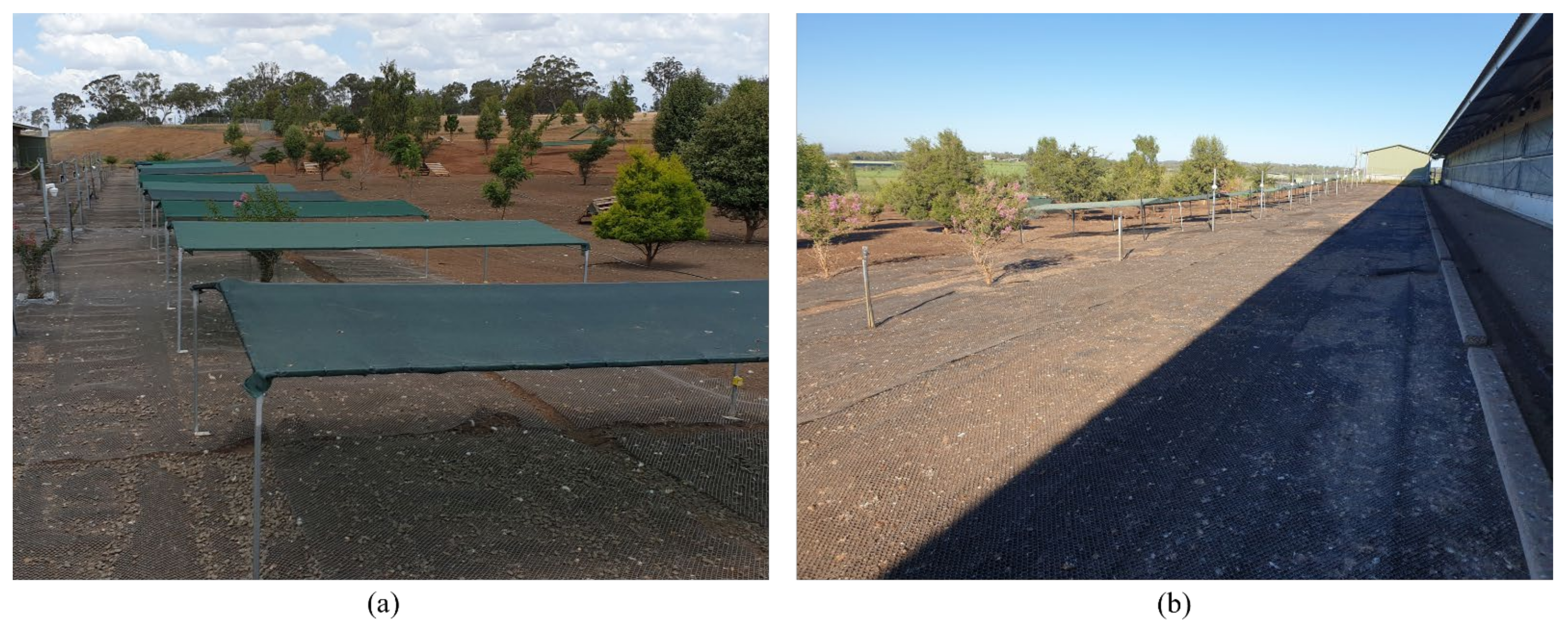
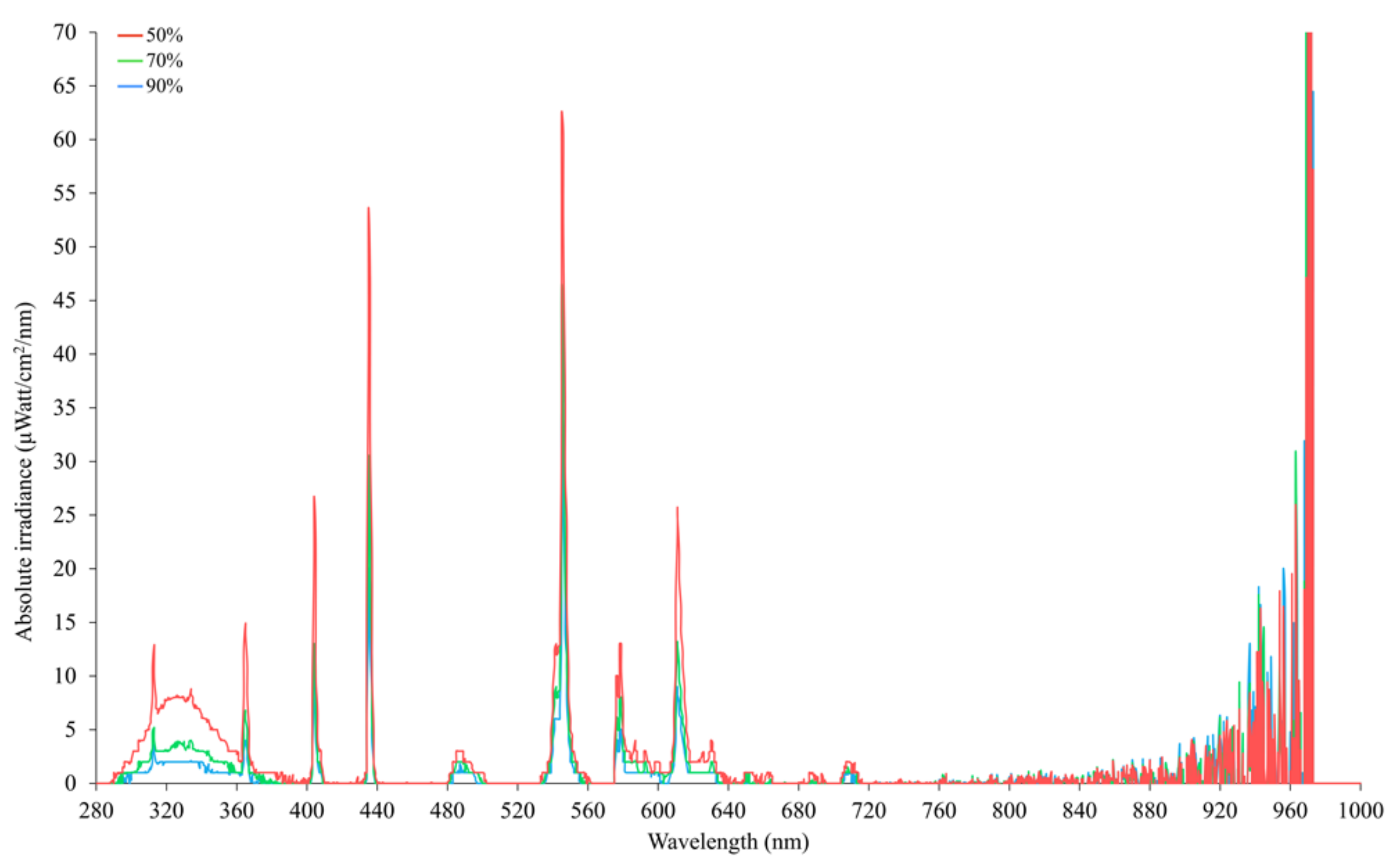


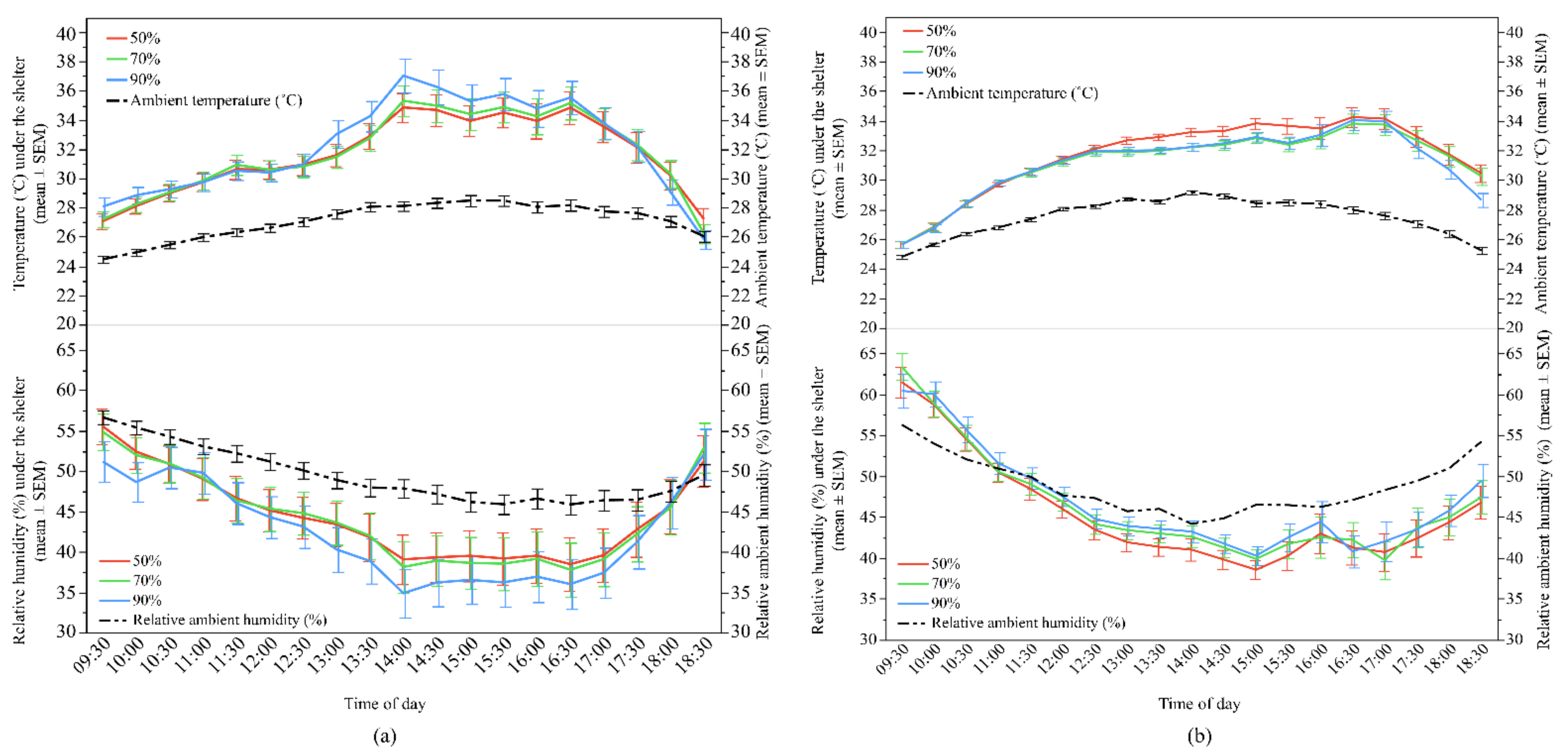
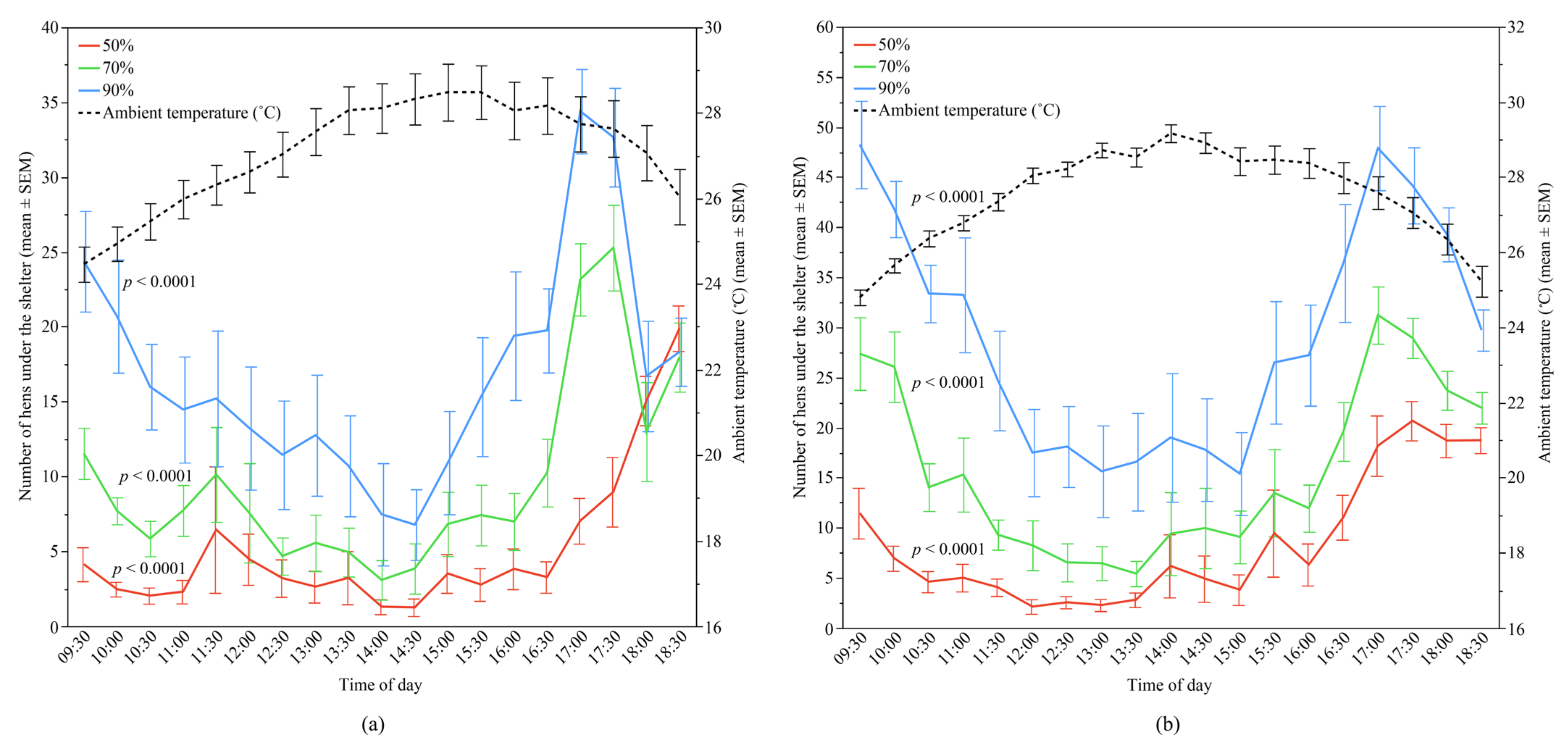
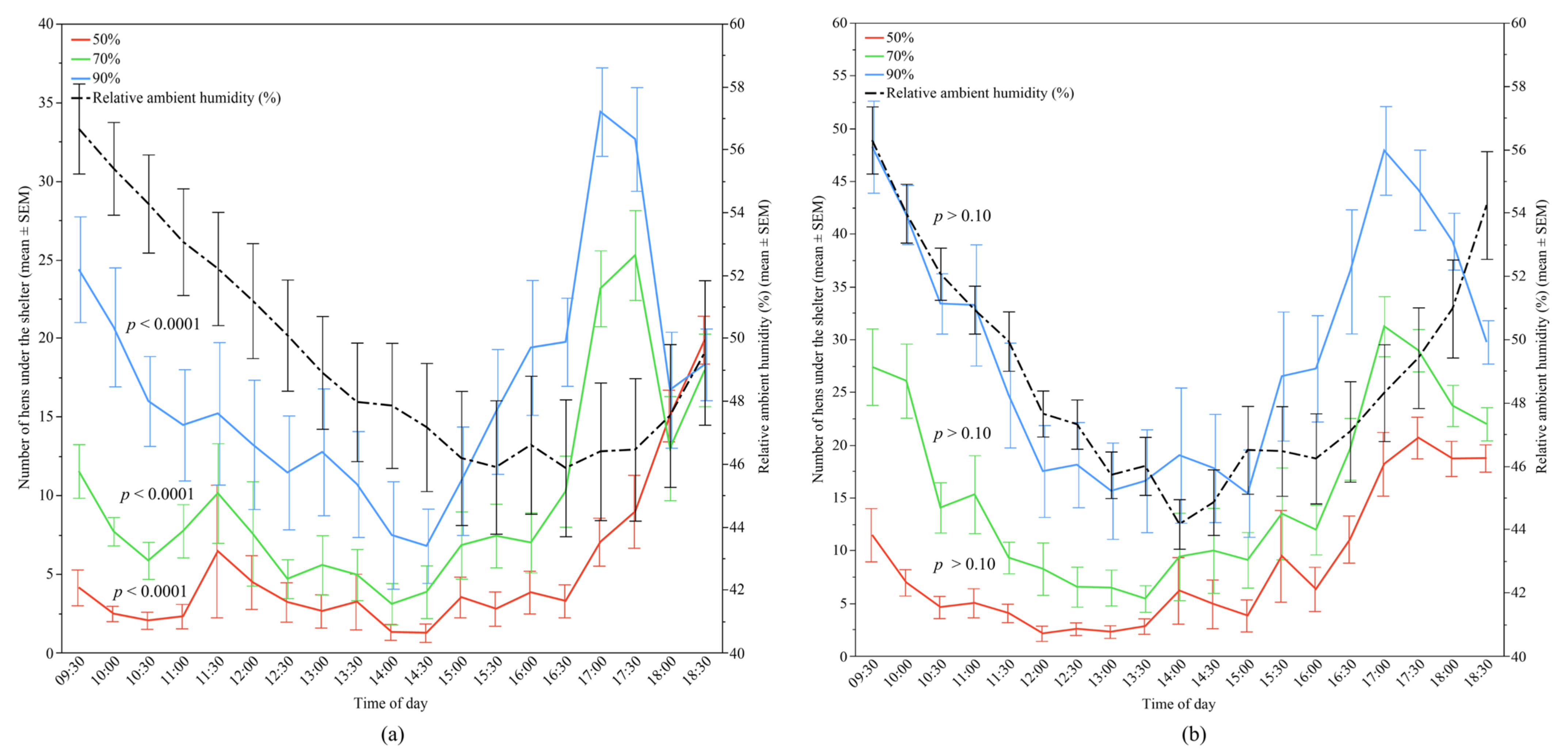
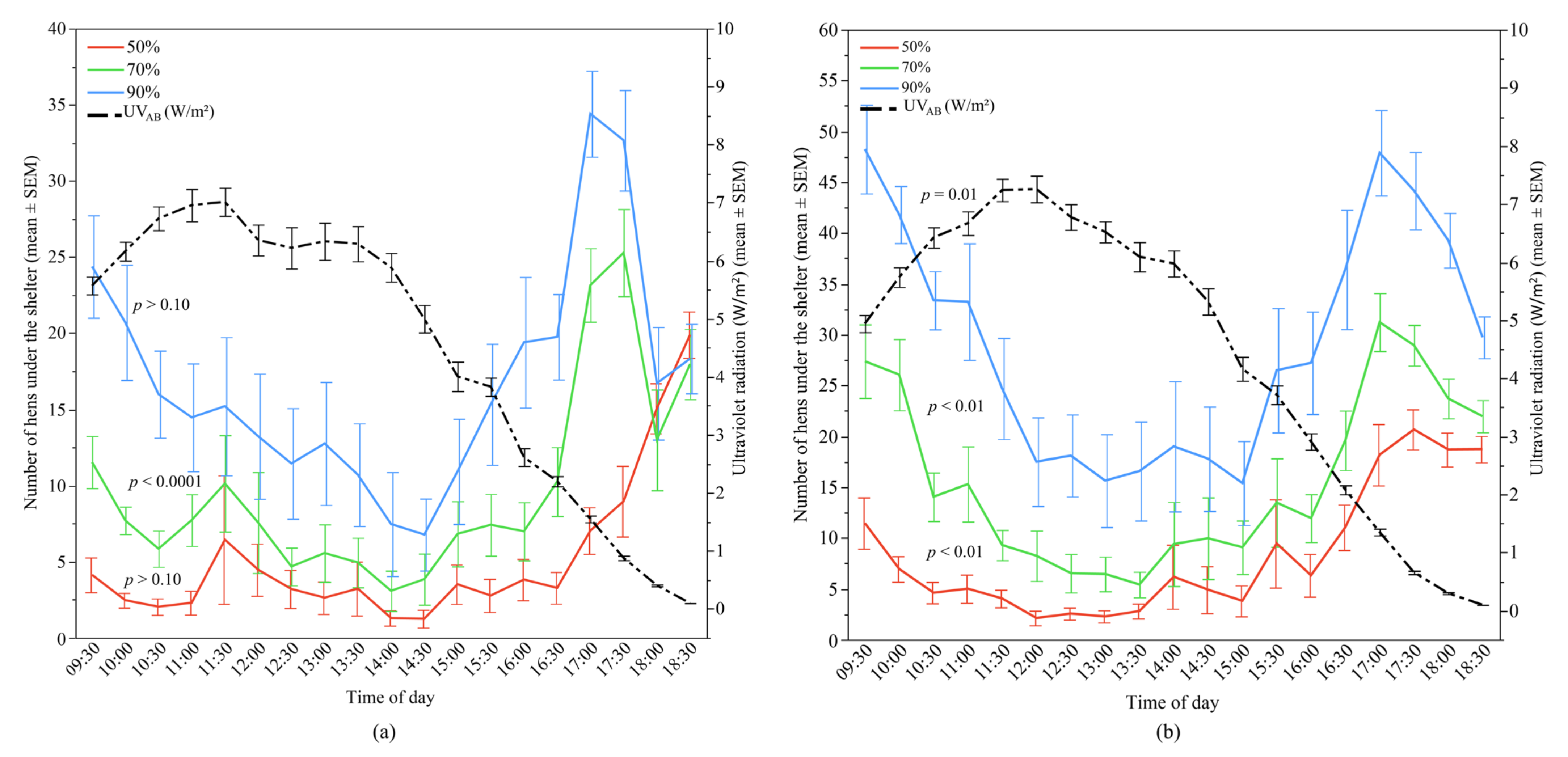

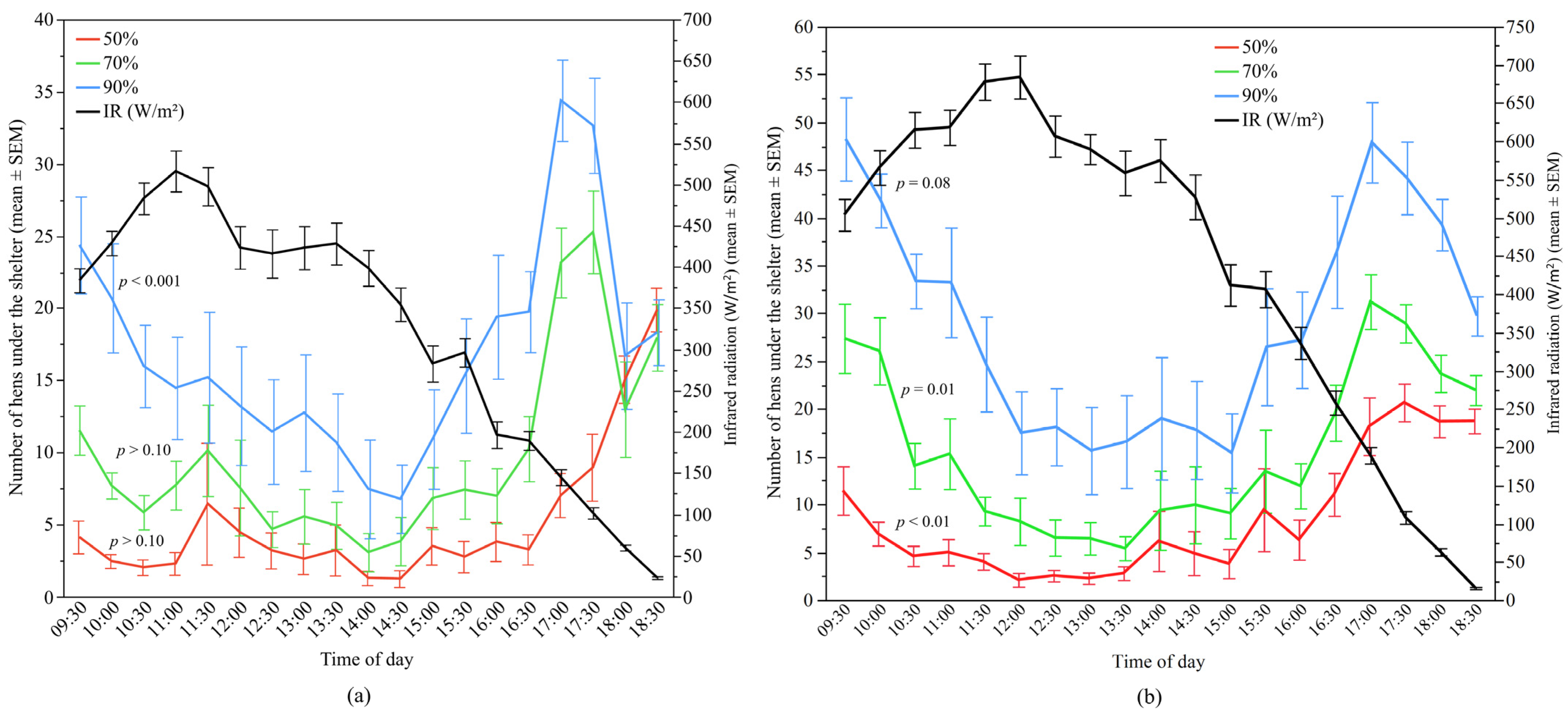
| Flock | Predictor 1 | β- Coefficient (Standardised) ‡ | t-Value | p-Value | Adjusted R2 and Model’s F-Statistics | Relative Weight of the Predictors in the Model |
|---|---|---|---|---|---|---|
| Flock-A | Ambient temperature | −0.70 | −12.61 | <0.0001 | R2-adjusted = 0.34 | 33.54% |
| Relative ambient humidity | −0.46 | −8.29 | <0.0001 | F3.35, 794.24 = 120.50, p < 0.0001 | 13.86% | |
| UVAB | −0.15 | −2.17 | 0.03 | 25.36% | ||
| IR | −0.24 | −3.37 | 0.001 | 27.24% | ||
| Flock-B | Ambient temperature | −0.41 | −15.90 | <0.0001 | R2-adjusted = 0.36 | 49.01% |
| UVAB | −0.27 | −3.78 | <0.001 | F2.68, 965.98 = 146.64, p < 0.0001 | 16.88% | |
| PAR | 0.10 | 2.07 | 0.04 | 16.84% | ||
| IR | −0.19 | −3.70 | <0.001 | 17.28% |
| UV-Filtering Shelter | Flock | Predictor 1 | Β-Coefficient (Standardised) ‡ | t-Value | p-Value | Adjusted R2 and Model’s F-Statistics | Relative Weight of the Predictors in the Model |
|---|---|---|---|---|---|---|---|
| 50% | A | Ambient temperature | −0.59 | −7.16 | <0.0001 | R2-adjusted = 0.52 | 24.62% |
| Relative ambient humidity | −0.36 | −4.42 | <0.0001 | F2.79, 263.03 = 108.58, p < 0.0001 | 10.52% | ||
| PAR | −0.56 | −13.25 | <0.0001 | 64.86% | |||
| B | Ambient temperature | −0.40 | −11.24 | <0.0001 | R2-adjusted = 0.58 | 34.26% | |
| UVAB | −0.29 | −3.18 | <0.01 | F2.53, 320.19 = 156.77, p < 0.0001 | 32.43% | ||
| IR | −0.28 | −3.08 | <0.01 | 33.31% | |||
| 70% | A | Ambient temperature | −0.77 | −8.48 | <0.0001 | R2-adjusted = 0.40 | 38.52% |
| Relative ambient humidity | −0.46 | −5.11 | <0.0001 | F2.79, 263.03 = 71.33, p < 0.0001 | 15.64% | ||
| UVAB | −0.41 | −8.87 | <0.0001 | 45.85% | |||
| B | Ambient temperature | −0.44 | −10.63 | <0.0001 | R2-adjusted = 0.44 | 45.57% | |
| UVAB | −0.33 | −2.85 | <0.01 | F2.68, 319.98 = 71.26, p < 0.0001 | 18.10% | ||
| PAR | 0.13 | 1.66 | 0.10 | 17.91% | |||
| IR | −0.22 | −2.70 | 0.01 | 18.42% | |||
| 90% | A | Ambient temperature | −0.93 | −9.99 | <0.0001 | R2-adjusted = 0.35 | 40.75% |
| Relative ambient humidity | −0.68 | −7.44 | <0.0001 | F3.08, 262.54 = 51.13, p < 0.0001 | 18.85% | ||
| PAR | 0.20 | 1.84 | 0.07 | 19.14% | |||
| IR | −0.53 | −4.92 | <0.0001 | 21.26% | |||
| B | Ambient temperature | −0.54 | −12.28 | <0.0001 | R2-adjusted = 0.38 | 71.58% | |
| UVAB | −0.31 | −2.51 | 0.01 | F2.68, 319.98 = 56.45, p < 0.0001 | 9.20% | ||
| PAR | 0.24 | 2.85 | <0.01 | 9.58% | |||
| IR | −0.15 | −1.78 | 0.08 | 9.63% |
Publisher’s Note: MDPI stays neutral with regard to jurisdictional claims in published maps and institutional affiliations. |
© 2022 by the authors. Licensee MDPI, Basel, Switzerland. This article is an open access article distributed under the terms and conditions of the Creative Commons Attribution (CC BY) license (https://creativecommons.org/licenses/by/4.0/).
Share and Cite
Rana, M.S.; Lee, C.; Lea, J.M.; Campbell, D.L.M. Commercial Free-Range Laying Hens’ Preferences for Shelters with Different Sunlight Filtering Percentages. Animals 2022, 12, 344. https://doi.org/10.3390/ani12030344
Rana MS, Lee C, Lea JM, Campbell DLM. Commercial Free-Range Laying Hens’ Preferences for Shelters with Different Sunlight Filtering Percentages. Animals. 2022; 12(3):344. https://doi.org/10.3390/ani12030344
Chicago/Turabian StyleRana, Md Sohel, Caroline Lee, Jim M. Lea, and Dana L. M. Campbell. 2022. "Commercial Free-Range Laying Hens’ Preferences for Shelters with Different Sunlight Filtering Percentages" Animals 12, no. 3: 344. https://doi.org/10.3390/ani12030344
APA StyleRana, M. S., Lee, C., Lea, J. M., & Campbell, D. L. M. (2022). Commercial Free-Range Laying Hens’ Preferences for Shelters with Different Sunlight Filtering Percentages. Animals, 12(3), 344. https://doi.org/10.3390/ani12030344







